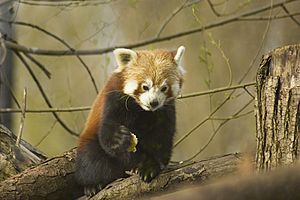Birmingham Wildlife Conservation Park facts for kids

Entrance in 2014
|
|
| Date opened | 1974 |
|---|---|
| Location | Pershore Road Edgbaston Birmingham England United Kingdom |
| Land area | 6.5 acres (2.6 ha) |
| Coordinates | 52°27′02″N 1°54′38″W / 52.450498°N 1.910430°W |
| Memberships | BIAZA, EAZA |
| Major exhibits | Red Pandas, European Lynx, Lemur, Northern Bald Ibis, Utila iguana, Cotton Topped Tamarins |
| Website | Birmingham Wildlife Conservation Park |
The Birmingham Wildlife Conservation Park is a cool small zoo in Birmingham, England. It's right next to Cannon Hill Park. This park used to be called the Birmingham Nature Centre. Before that, it was known as the Birmingham Zoo.
The city council of Birmingham owns and runs this special park. It's not just for fun visits, though! The park also helps with important science projects. These include breeding programmes for animals that are in danger. They also teach people about protecting the world's amazing animals.
The park is part of two big groups. These are the British and Irish Association of Zoos and Aquariums (BIAZA) and the European Association of Zoos and Aquaria (EAZA). Being part of these groups means they follow high standards for animal care.
Contents
Discover the Park's History
The zoo first opened its doors on 1 May 1964. It was called Birmingham Zoo back then. The Dudley Zoological Society started it inside Cannon Hill Park. This area was once home to an old mill from the 1500s.
The zoo was planned to show mostly young animals. But it also had monkeys from Dudley Zoo. Plus, there were two dromedaries for rides! People used to call it a "little gem" of a zoo.
It closed for a short time in 1973. Then, in 1974, Birmingham City Council reopened it. It was given a new name: the Birmingham Nature Centre. The entrance was part of the Birmingham Natural History Museum. In 2014, it changed its name again. It became the Birmingham Wildlife Conservation Park.
Meet the Amazing Animals
The Birmingham Wildlife Conservation Park is home to many awesome animals. Most of them are small mammals. Here are some of the cool creatures you can see:
- A group of Bagot goats
- Asian small-clawed otters
- Meerkats
- Lynxes
- Black-and-white ruffed lemurs
- Ring-tailed lemurs
- Mouse lemurs
- Malagasy giant rats
- Golden-headed lion tamarins
- Goeldi's marmosets
- Squirrel monkeys
- Pied tamarins
- Golden lion tamarins
- Ocelots
- African brush-tailed porcupines
- Red-necked wallabys
- Capybaras
- Red squirrels
- Special farm animals from old breeds
- Different kinds of owls
- Greater rheas
- Armadillos
- Northern bald ibises
- Wattled cranes
- Blue cranes
- Various Reptiles
- Jamaican boas
- Komodo Dragons
- Many interesting Insects
- Sloths
Red Pandas: A Special Story
The park used to have two male red pandas. They were moved to other zoos. This was part of a national plan to help red pandas have babies. One of them, Ming Ming, went to visit a female red panda. She lives at the Welsh Mountain Zoo.
Babu's Big Adventure
One red panda named Babu had an exciting adventure! In November 2005, he disappeared from the park. He was missing for four days! Park staff think he might have been blown out of a tree. This would have taken him outside his home.
Babu's disappearance made headlines across the country. Everyone in the city was looking for him! A person walking their dog in Moseley finally found him. Babu was then reunited with his brother, Tensing. This happy moment was even shown live on TV!


